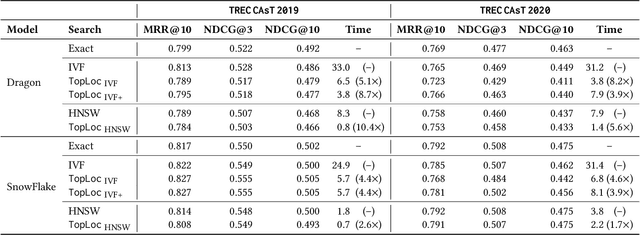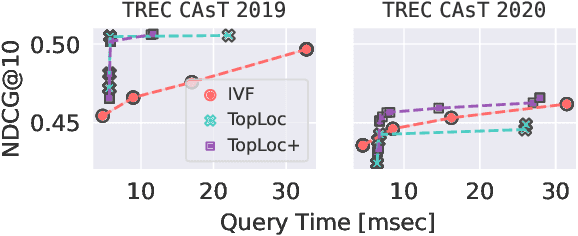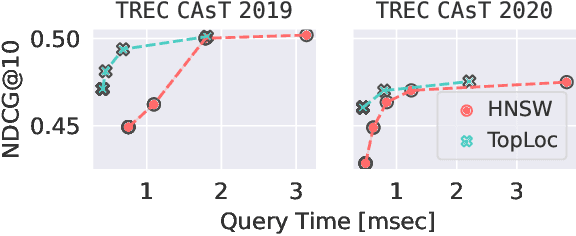Franco Maria Nardini
Early-Exit Graph Neural Networks
May 23, 2025Abstract:Early-exit mechanisms allow deep neural networks to halt inference as soon as classification confidence is high enough, adaptively trading depth for confidence, and thereby cutting latency and energy on easy inputs while retaining full-depth accuracy for harder ones. Similarly, adding early exit mechanisms to Graph Neural Networks (GNNs), the go-to models for graph-structured data, allows for dynamic trading depth for confidence on simple graphs while maintaining full-depth accuracy on harder and more complex graphs to capture intricate relationships. Although early exits have proven effective across various deep learning domains, their potential within GNNs in scenarios that require deep architectures while resisting over-smoothing and over-squashing remains largely unexplored. We unlock that potential by first introducing Symmetric-Anti-Symmetric Graph Neural Networks (SAS-GNN), whose symmetry-based inductive biases mitigate these issues and yield stable intermediate representations that can be useful to allow early exiting in GNNs. Building on this backbone, we present Early-Exit Graph Neural Networks (EEGNNs), which append confidence-aware exit heads that allow on-the-fly termination of propagation based on each node or the entire graph. Experiments show that EEGNNs preserve robust performance as depth grows and deliver competitive accuracy on heterophilic and long-range benchmarks, matching attention-based and asynchronous message-passing models while substantially reducing computation and latency. We plan to release the code to reproduce our experiments.
Effective Inference-Free Retrieval for Learned Sparse Representations
Apr 30, 2025Abstract:Learned Sparse Retrieval (LSR) is an effective IR approach that exploits pre-trained language models for encoding text into a learned bag of words. Several efforts in the literature have shown that sparsity is key to enabling a good trade-off between the efficiency and effectiveness of the query processor. To induce the right degree of sparsity, researchers typically use regularization techniques when training LSR models. Recently, new efficient -- inverted index-based -- retrieval engines have been proposed, leading to a natural question: has the role of regularization changed in training LSR models? In this paper, we conduct an extended evaluation of regularization approaches for LSR where we discuss their effectiveness, efficiency, and out-of-domain generalization capabilities. We first show that regularization can be relaxed to produce more effective LSR encoders. We also show that query encoding is now the bottleneck limiting the overall query processor performance. To remove this bottleneck, we advance the state-of-the-art of inference-free LSR by proposing Learned Inference-free Retrieval (Li-LSR). At training time, Li-LSR learns a score for each token, casting the query encoding step into a seamless table lookup. Our approach yields state-of-the-art effectiveness for both in-domain and out-of-domain evaluation, surpassing Splade-v3-Doc by 1 point of mRR@10 on MS MARCO and 1.8 points of nDCG@10 on BEIR.
Efficient Conversational Search via Topical Locality in Dense Retrieval
Apr 30, 2025


Abstract:Pre-trained language models have been widely exploited to learn dense representations of documents and queries for information retrieval. While previous efforts have primarily focused on improving effectiveness and user satisfaction, response time remains a critical bottleneck of conversational search systems. To address this, we exploit the topical locality inherent in conversational queries, i.e., the tendency of queries within a conversation to focus on related topics. By leveraging query embedding similarities, we dynamically restrict the search space to semantically relevant document clusters, reducing computational complexity without compromising retrieval quality. We evaluate our approach on the TREC CAsT 2019 and 2020 datasets using multiple embedding models and vector indexes, achieving improvements in processing speed of up to 10.4X with little loss in performance (4.4X without any loss). Our results show that the proposed system effectively handles complex, multiturn queries with high precision and efficiency, offering a practical solution for real-time conversational search.
Investigating the Scalability of Approximate Sparse Retrieval Algorithms to Massive Datasets
Jan 20, 2025


Abstract:Learned sparse text embeddings have gained popularity due to their effectiveness in top-k retrieval and inherent interpretability. Their distributional idiosyncrasies, however, have long hindered their use in real-world retrieval systems. That changed with the recent development of approximate algorithms that leverage the distributional properties of sparse embeddings to speed up retrieval. Nonetheless, in much of the existing literature, evaluation has been limited to datasets with only a few million documents such as MSMARCO. It remains unclear how these systems behave on much larger datasets and what challenges lurk in larger scales. To bridge that gap, we investigate the behavior of state-of-the-art retrieval algorithms on massive datasets. We compare and contrast the recently-proposed Seismic and graph-based solutions adapted from dense retrieval. We extensively evaluate Splade embeddings of 138M passages from MsMarco-v2 and report indexing time and other efficiency and effectiveness metrics.
kANNolo: Sweet and Smooth Approximate k-Nearest Neighbors Search
Jan 10, 2025Abstract:Approximate Nearest Neighbors (ANN) search is a crucial task in several applications like recommender systems and information retrieval. Current state-of-the-art ANN libraries, although being performance-oriented, often lack modularity and ease of use. This translates into them not being fully suitable for easy prototyping and testing of research ideas, an important feature to enable. We address these limitations by introducing kANNolo, a novel research-oriented ANN library written in Rust and explicitly designed to combine usability with performance effectively. kANNolo is the first ANN library that supports dense and sparse vector representations made available on top of different similarity measures, e.g., euclidean distance and inner product. Moreover, it also supports vector quantization techniques, e.g., Product Quantization, on top of the indexing strategies implemented. These functionalities are managed through Rust traits, allowing shared behaviors to be handled abstractly. This abstraction ensures flexibility and facilitates an easy integration of new components. In this work, we detail the architecture of kANNolo and demonstrate that its flexibility does not compromise performance. The experimental analysis shows that kANNolo achieves state-of-the-art performance in terms of speed-accuracy trade-off while allowing fast and easy prototyping, thus making kANNolo a valuable tool for advancing ANN research. Source code available on GitHub: https://github.com/TusKANNy/kannolo.
Power- and Fragmentation-aware Online Scheduling for GPU Datacenters
Dec 23, 2024



Abstract:The rise of Artificial Intelligence and Large Language Models is driving increased GPU usage in data centers for complex training and inference tasks, impacting operational costs, energy demands, and the environmental footprint of large-scale computing infrastructures. This work addresses the online scheduling problem in GPU datacenters, which involves scheduling tasks without knowledge of their future arrivals. We focus on two objectives: minimizing GPU fragmentation and reducing power consumption. GPU fragmentation occurs when partial GPU allocations hinder the efficient use of remaining resources, especially as the datacenter nears full capacity. A recent scheduling policy, Fragmentation Gradient Descent (FGD), leverages a fragmentation metric to address this issue. Reducing power consumption is also crucial due to the significant power demands of GPUs. To this end, we propose PWR, a novel scheduling policy to minimize power usage by selecting power-efficient GPU and CPU combinations. This involves a simplified model for measuring power consumption integrated into a Kubernetes score plugin. Through an extensive experimental evaluation in a simulated cluster, we show how PWR, when combined with FGD, achieves a balanced trade-off between reducing power consumption and minimizing GPU fragmentation.
Rewriting Conversational Utterances with Instructed Large Language Models
Oct 10, 2024Abstract:Many recent studies have shown the ability of large language models (LLMs) to achieve state-of-the-art performance on many NLP tasks, such as question answering, text summarization, coding, and translation. In some cases, the results provided by LLMs are on par with those of human experts. These models' most disruptive innovation is their ability to perform tasks via zero-shot or few-shot prompting. This capability has been successfully exploited to train instructed LLMs, where reinforcement learning with human feedback is used to guide the model to follow the user's requests directly. In this paper, we investigate the ability of instructed LLMs to improve conversational search effectiveness by rewriting user questions in a conversational setting. We study which prompts provide the most informative rewritten utterances that lead to the best retrieval performance. Reproducible experiments are conducted on publicly-available TREC CAST datasets. The results show that rewriting conversational utterances with instructed LLMs achieves significant improvements of up to 25.2% in MRR, 31.7% in Precision@1, 27% in NDCG@3, and 11.5% in Recall@500 over state-of-the-art techniques.
Early Exit Strategies for Approximate k-NN Search in Dense Retrieval
Aug 09, 2024Abstract:Learned dense representations are a popular family of techniques for encoding queries and documents using high-dimensional embeddings, which enable retrieval by performing approximate k nearest-neighbors search (A-kNN). A popular technique for making A-kNN search efficient is based on a two-level index, where the embeddings of documents are clustered offline and, at query processing, a fixed number N of clusters closest to the query is visited exhaustively to compute the result set. In this paper, we build upon state-of-the-art for early exit A-kNN and propose an unsupervised method based on the notion of patience, which can reach competitive effectiveness with large efficiency gains. Moreover, we discuss a cascade approach where we first identify queries that find their nearest neighbor within the closest t << N clusters, and then we decide how many more to visit based on our patience approach or other state-of-the-art strategies. Reproducible experiments employing state-of-the-art dense retrieval models and publicly available resources show that our techniques improve the A-kNN efficiency with up to 5x speedups while achieving negligible effectiveness losses. All the code used is available at https://github.com/francescobusolin/faiss_pEE
Pairing Clustered Inverted Indexes with kNN Graphs for Fast Approximate Retrieval over Learned Sparse Representations
Aug 08, 2024



Abstract:Learned sparse representations form an effective and interpretable class of embeddings for text retrieval. While exact top-k retrieval over such embeddings faces efficiency challenges, a recent algorithm called Seismic has enabled remarkably fast, highly-accurate approximate retrieval. Seismic statically prunes inverted lists, organizes each list into geometrically-cohesive blocks, and augments each block with a summary vector. At query time, each inverted list associated with a query term is traversed one block at a time in an arbitrary order, with the inner product between the query and summaries determining if a block must be evaluated. When a block is deemed promising, its documents are fully evaluated with a forward index. Seismic is one to two orders of magnitude faster than state-of-the-art inverted index-based solutions and significantly outperforms the winning graph-based submissions to the BigANN 2023 Challenge. In this work, we speed up Seismic further by introducing two innovations to its query processing subroutine. First, we traverse blocks in order of importance, rather than arbitrarily. Second, we take the list of documents retrieved by Seismic and expand it to include the neighbors of each document using an offline k-regular nearest neighbor graph; the expanded list is then ranked to produce the final top-k set. Experiments on two public datasets show that our extension, named SeismicWave, can reach almost-exact accuracy levels and is up to 2.2x faster than Seismic.
Optimistic Query Routing in Clustering-based Approximate Maximum Inner Product Search
May 20, 2024Abstract:Clustering-based nearest neighbor search is a simple yet effective method in which data points are partitioned into geometric shards to form an index, and only a few shards are searched during query processing to find an approximate set of top-$k$ vectors. Even though the search efficacy is heavily influenced by the algorithm that identifies the set of shards to probe, it has received little attention in the literature. This work attempts to bridge that gap by studying the problem of routing in clustering-based maximum inner product search (MIPS). We begin by unpacking existing routing protocols and notice the surprising contribution of optimism. We then take a page from the sequential decision making literature and formalize that insight following the principle of ``optimism in the face of uncertainty.'' In particular, we present a new framework that incorporates the moments of the distribution of inner products within each shard to optimistically estimate the maximum inner product. We then present a simple instance of our algorithm that uses only the first two moments to reach the same accuracy as state-of-the-art routers such as \scann by probing up to $50%$ fewer points on a suite of benchmark MIPS datasets. Our algorithm is also space-efficient: we design a sketch of the second moment whose size is independent of the number of points and in practice requires storing only $O(1)$ additional vectors per shard.
 Add to Chrome
Add to Chrome Add to Firefox
Add to Firefox Add to Edge
Add to Edge